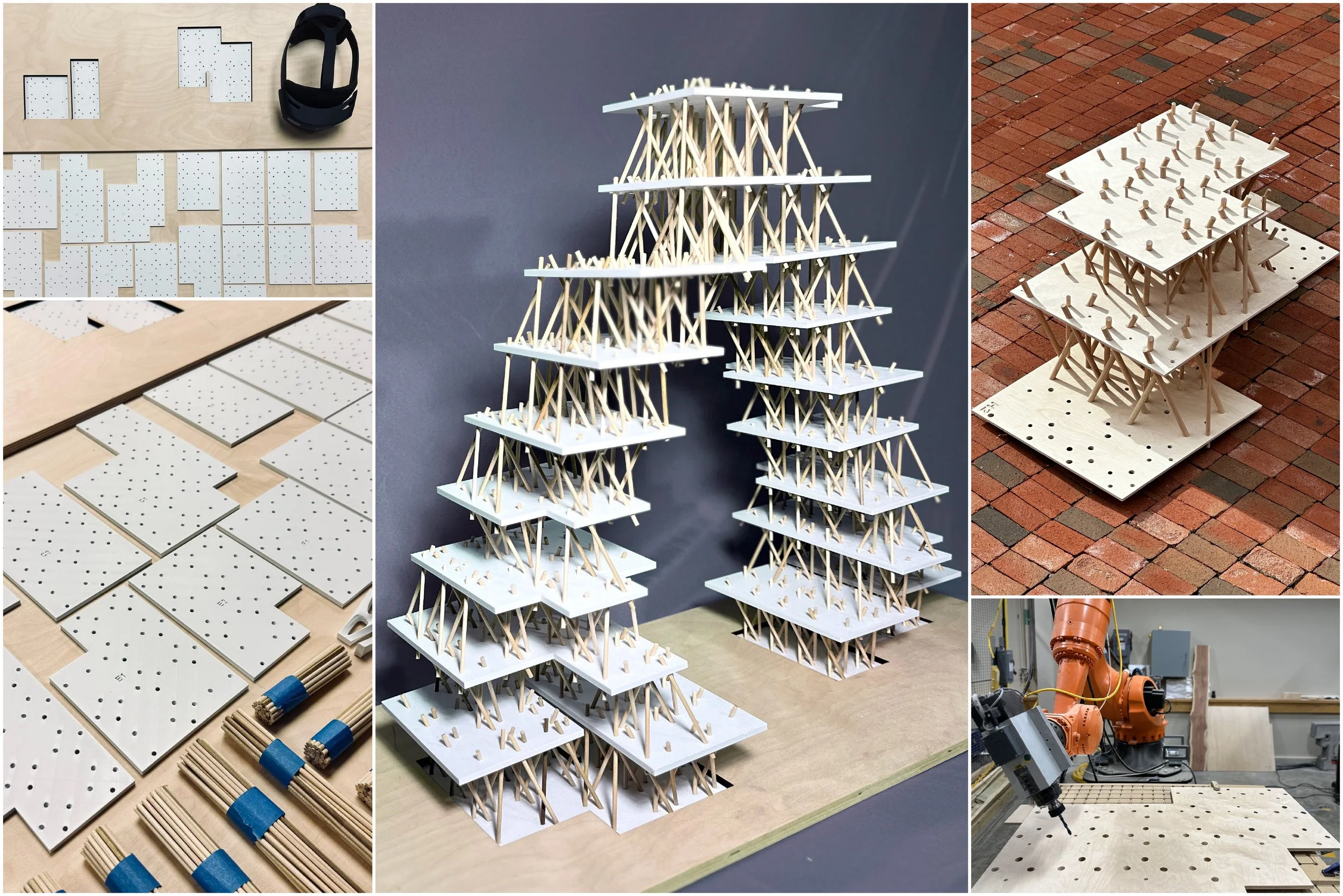Peer Reviewed Publication: eCAADe 2025 Proceedings “Integrated Computational Design for the Jointless Reciprocal Lattice Structure Fabrication” S.Mostafavi, T.Ghiyasi, B.Bagheri, E.Montejano, C.Howell
Scaled models of an arch structure using reciprocal lattice systems, middle and arch case study using TDRL, Right: Robotic fabrication of timber elements for the lattice assembly.
Integrated Computational Design for the Fabrication of Jointless Reciprocal Lattice Structure
Paper Published in eCAADe 2025 - Ankara
The paper titled
“Reciprocal Lattice: A jointless discrete system of topologically optimized timber-plates and varied profile dowels ”
authored by Sina Mostafavi, Tahmures Ghiyasi, Bahar Bagheri, Edgar Montejano Hernandez, and Cole Howell, has been published in the proceedings of eCAADe 2025, part of the Computer Aided Architectural Design Conference held September 01–05, 2025, in Ankara, Turkey.
Project Summary
This research introduces a computational design-to-production introduces a resource-driven, lightweight method for designing and constructing lattice structures, offering a scalable and modular assembly approach without the need for secondary materials. The results focus on validating this system through the compound column case study, emphasizing material efficiency and structural performance. By focusing on the discrete assembly of topologically optimized timber plates (TOT) and varied profile dowels (VPD), the system demonstrates its potential for material efficiency, lightweight, and scalable lattice structures. The research highlights the interplay between structural optimization and material efficiency, emphasizing the importance of modular and jointless assembly in advancing sustainable timber construction practices.
Academic Context & Collaboration
The research was developed as part of an ongoing body of work at the Hi-DARS Lab (Hybrid Intelligence Design and Architectural Robotic Systems Lab) at the Huckabee College of Architecture, Texas Tech University, initiated in the Spring 2024 ARCH 5334: Advanced Architectural Technology I course taught by Dr. Sina Mostafavi.
The computational and augmented fabrication methods were further developed by Bahar Bagheri, Sina Mostafavi, and Edgar Montejano, each contributing to specific layers of the system.
Future work will also focus on testing the JRL system at different scales, including one-to-one fabrication and load-bearing tests of optimized timber-dowel reciprocal lattice systems.
🔗 Read the full paper (eCAADe2025)
#eCAADe2025 #HiDARS #TexasTechArchitecture #TimberDowelStructures #ComputationalDesign #RoboticWood #ARAssembly #AugmentedFabrication #CoProduction #CircularConstruction #ArchitectureResearch
Abstract
This paper presents the design and development of an integrated computational system for the fabrication of jointless reciprocal lattice structures. The focus is on discrete assembly techniques for timber-based columns, where structural stability is achieved through self-balancing counter forces generated by the reciprocal arrangement of varied profile dowels. These dowels are inserted through topologically optimized timber-plates at counter-balancing orientations, guided by the spatial angles of the lattice’s voxel units, resulting in stable configurations without the use of adhesives or secondary fasteners. The design process incorporates voxel-based polyhedral modeling and parametric structural analysis to optimize both material distribution across plates and dowel profile allocation. Due to its modular nature, the system is compatible with robotic fabrication and augmented reality-enabled assembly. A set of column configurations is explored, with one selected case examined in detail through physical prototyping. The findings situate the system within circular material workflows for timber construction.
Keywords: Jointless Reciprocal Lattice, Timber Dowel Column, Robotic Timber Construction, Augmented Fabrication, Resource-Driven Design
Acknowledgements
The authors acknowledge the support of the Office of Research and Commercialization for filing a USpatent related to this work, filed on June 21, 2024. This work also benefited from the support of TTUHCOA, Hi-DARS lab members.








